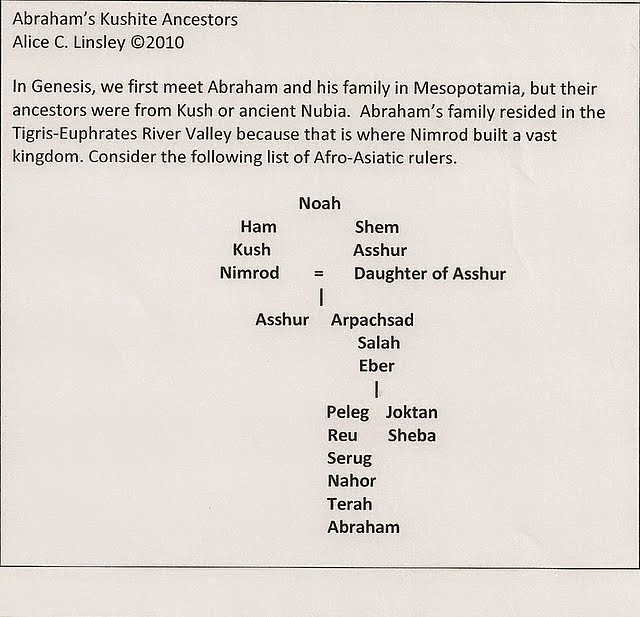Posted By Alice C. Linsley,
Tuesday, January 13, 2015
|
Alice C. Linsley
I recently had a conversation with a man named Toshio who wanted to know how I came to the conclusion that Abraham was a descendant of Nimrod. He was not satisfied by my answers:
Nimrod was a Kushite ruler, the son of Kush, according to Genesis 10. He was a sent-away son like Abraham, Moses, Jacob, David and Jesus Christ. It is to the sent-away sons that God delivers a kingdom. These sons are the heroes of biblical history. Nimrod was such a son. This means that he was not in line to ascend to the throne of his father Kush. He and his brother Raamah (Gen. 10:6-12) established themselves as rulers in territories to the east. Raamah ruled in Southern Arabia. Nimrod's relocation to the Tigris-Euphrates Valley represents the Kushite migration out of the Nile Valley, something that has been confirmed by DNA studies and by evidence in other sciences. This migration of the Kushite rulers out of Africa was driven by their marriage and ascendancy pattern.
Linguistically, the language of Nimrod's kingdom - Akkadian - has close affinity to the languages of the ancient Nile Valley as has been demonstrated by Christopher Ehret's research. Ehret also recognizes that cattle were domesticated in Sudan as early as 9000 year ago. These cattle-herding Proto-Saharan or Saharo-Nubian peoples were among Abraham's ancestors.
Molecular genetics also confirms the Biblical data that points to the cradle of modern languages being between Lake Chad (Noah's homeland) and the Nile Valley. See this from the European Journal of Human Genetics advance online publication 26 March 2014; doi: 10.1038/ejhg.2014.41
Y-chromosome E haplogroups: their distribution and implication to the origin of Afro-Asiatic languages and pastoralism
Eyoab I Gebremeskel and Muntaser E Ibrahim
Archeological and paleontological evidences point to East Africa as the likely area of early evolution of modern humans. Genetic studies also indicate that populations from the region often contain, but not exclusively, representatives of the more basal clades of mitochondrial and Y-chromosome phylogenies. Most Y-chromosome haplogroup diversity in Africa, however, is present within macrohaplogroup E that seem to have appeared 21 000–32 000 YBP somewhere between the Red Sea and Lake Chad. The combined analysis of 17 bi-allelic markers in 1214 Y chromosomes together with cultural background of 49 populations displayed in various metrics: network, multidimensional scaling, principal component analysis and neighbor-joining plots, indicate a major contribution of East African populations to the foundation of the macrohaplogroup, suggesting a diversification that predates the appearance of some cultural traits and the subsequent expansion that is more associated with the cultural and linguistic diversity witnessed today. The proto-Afro-Asiatic group carrying the E-P2 mutation may have appeared at this point in time and subsequently gave rise to the different major population groups including current speakers of the Afro-Asiatic languages and pastoralist populations.
Analysis of the Lamech segment shows that the lines of Cain and Seth intermarried, which means that Abraham is a descendant of both rulers. The lines of Ham and Shem intermarried also, which means that Abraham is a descendant of both those rulers.
Analysis of the marriage and ascendancy pattern of Abraham's ancestors reveals a fixed pattern for the ruler who ascends to the throne. That pattern applies to Lamech the Elder, Nahor the Elder, Terah, Abraham, Jacob, Esau, Amram, Moses and Elkanah, Samuel's father.
Here is the diagram showing the intermarriage of the lines of Ham and Shem and Nimrod's marriage to his patrilineal cousin. Note that she named their first born son after her father, following the pattern of these rulers. This is called the "cousin bride's naming prerogative." According to the marriage and ascendancy pattern of these Biblical rulers, Nimrod married a daughter of Asshur (Ash-Ur means throne of Ur). She would have been his second wife and this marriage took place shortly before he ascended to the throne of his father. His father was likely Sargon I. They were great kingdom builders of the ancient world.
Toshia was concerned that I cannot point to a place in the Bible that says Nimrod married the daughter of Asshur. I have reconstructed this based on the unchanging Horite marriage and ascendancy pattern that is found in Genesis. I am a scientist and I have to go by the best data available, especially when there has been consistent repetition of the marriage and ascendancy pattern. I apply the tools of anthropology to the Biblical text. I am a Biblical Anthropologist. Anthropology is a relatively new science, but it has developed some reliable methods and principles.
Science require observation of details and record keeping, and there is always the possibility that the next experiment might not provide the same results or conform to the hypothesis as did earlier experiments.
This radical doubt poses a problem for scientists. It means that the scientific method cannot be said to ascertain beyond doubt. This is Hume's problem of induction. Inductive methods predict or infer and are essential in scientific reasoning. One cannot assume that something is immutable and necessary because it has always or usually been reliable in the past. Though 20 experiments produce the same results, we have no certainty that the results will be the same after experiments 21, or 32 or 45. Though the sun has risen daily since the founding of our solar system, we have no certainty that it will always do so.
In 1953, Richard Rudner published "The Scientist qua Scientist Makes Value Judgments,” in which he argued that since no hypothesis is ever completely verified, in accepting a hypothesis the scientist must make the decision that the evidence is sufficiently strong to warrant the acceptance of the hypothesis. The problem of induction which David Hume framed so precisely is really a problem of decision about which action to take, not proof of the fallibility of science in general.
I assure my readers and Toshio that I have not tried to impose on the text something that is not there. My method is to begin with the Biblical text, trusting that it is reliable and truthful. Indeed, that is my working hypothesis.
Related reading: Genesis in Anthropological Perspective; Kushite Kings and the Kingdom of God; Nimrod Was a Nilo-Saharan Ruler; The Kushite Marriage Pattern Drove the Kushite Expansion; The Genesis King Lists; DNA Research Confirms Kushite Migration; The Descendants of Kain and Seth; The Nubian Context of YHWH; Solving the Ainu Mystery
Tags:
Biblical Anthropology
Permalink
| Comments (2)
|






Posted Tuesday, January 13, 2015